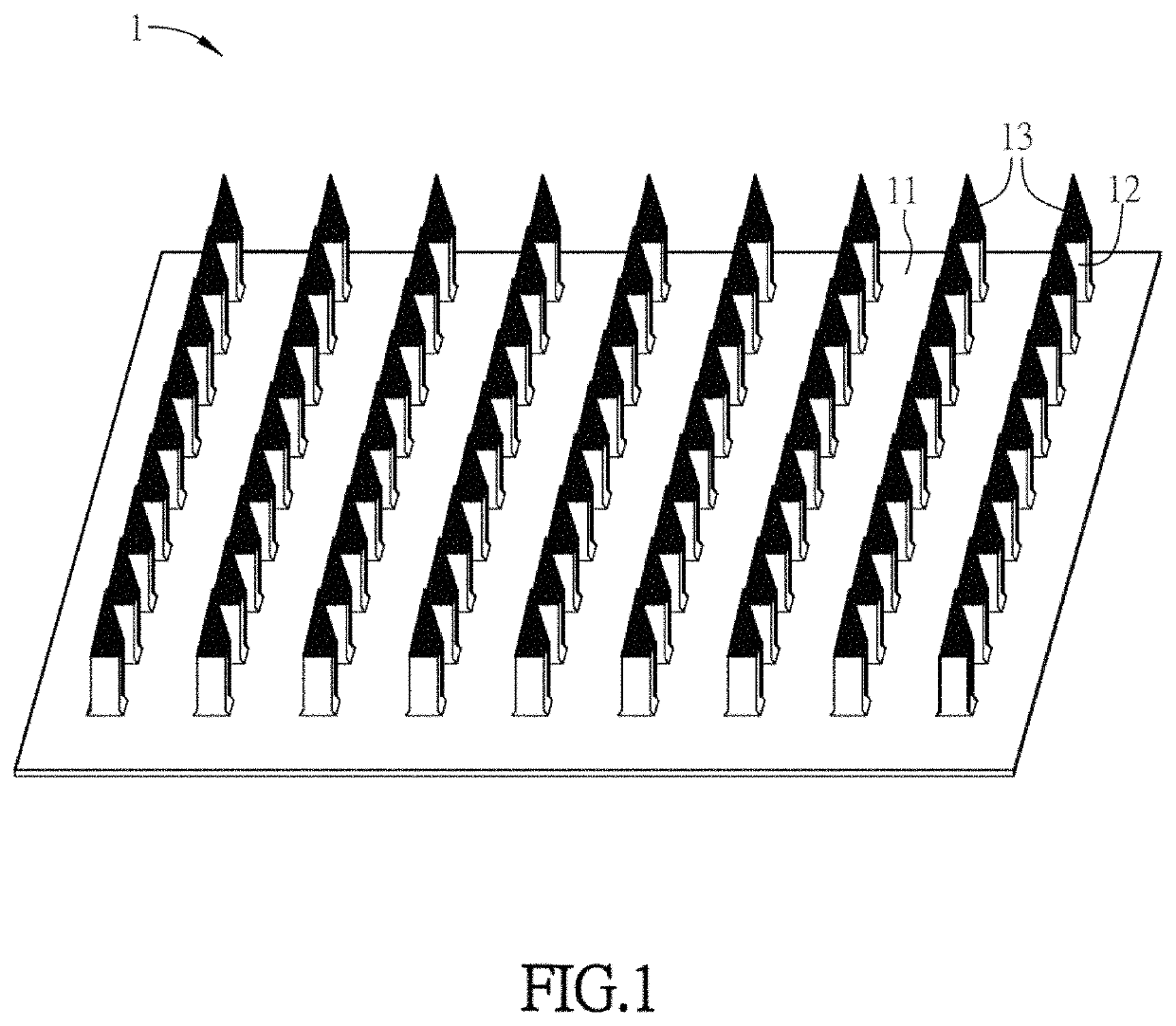Substance delivery device and substance delivery method using the same
a delivery device and substance technology, applied in the direction of intravenous devices, other medical devices, infusion needles, etc., can solve the problems of difficult to precisely control the efficacy of drugs, the whole process not only costs a lot of time, and the effect of prolonging the effect of the substan
- Summary
- Abstract
- Description
- Claims
- Application Information
AI Technical Summary
Benefits of technology
Problems solved by technology
Method used
Image
Examples
experiment 1
Manufacture of the Substance Delivery Device
[0079]Materials
[0080]Sodium hyaluronate (HA) with molecular weight (MW) of 7 kDa and 250 kDa was purchased from Bloomage Freda Biopharm (Jinan, China) and Kewpie (Tokyo, Japan), respectively. Chitosan (viscosity=22 mPa·s for 3.2% in 1% acetic acid at 20° C., and degree of deacetylation=91.2%,), γ-poly-glutamic acid (γ-PGA; Na+ form, MW approximately 1000 kDa), and PVA (MW=6000) were obtained from Koyo Chemical (Osaka, Japan), Vedan Enterprise Corp (Taichung, Taiwan), and Polysciences (Warrington, Pa., USA). Rhodamine 6G (MW=470), fluorescein 5(6)-isothiocyanate (FITC; MW=389), and PVP (MW=10000) were purchased from Sigma-Aldrich (St. Louis, Mo., USA).
[0081]Manufacture of Molds
[0082]Polydimethylsiloxane solution is prepared by mixing agent A with agent B in a ratio of 10:1 and then incubating in a shaking bath. The bubble in the solution is removed, and stainless steel mother molds of microneedles (as shown in FIG. 7A) and supporting struct...
experiment 2
In Vitro Skin-Insertion
[0089]Substance delivery device including dissolvable substrate, dissolvable supporting structure, and carriers is prepared. To assess whether the chitosan microneedle has sufficient penetrating ability or not, porcine cadaver skin is used for in vitro insertion test.
[0090]Particularly, a microneedle patch applicator is used herein to assist and prevent an incomplete insertion caused by an uneven force. The structure of the applicator includes a spring and column. The spring is able to push the column and make the microneedle patch located at the front end of the column penetrate into the skin. The penetrating force can be adjusted by adjusting the spring. This device is able to assist users to insert the microneedles into skin within 3 seconds to achieve stable complete insertion.
[0091]Before insertion process, hairs of porcine cadaver skin are removed. After the treatment, the microneedle patch is inserted into porcine cadaver skin by using a homemade applic...
experiment 3
In Vivo Insertion and Wound Healing
[0093]The in vivo skin insertion ability of microneedles and the skin resealing after microneedle insertion were evaluated in three individuals, including ICR mice, Sprague-Dawley rat (SD rat) and LYD hog. Before insertion process, the hair of the pig skin is removed. The microneedle patch is fixed on the applicator and then inserted into the skin for 3 minutes. After the insertion process is done, the array marks caused by the microneedles inserting into skin is observed by optical microscopy. The result is shown in FIG. 10A˜10C.
[0094]FIG. 10A shows images of the skin of ICR mice after insertion of microneedles, FIG. 10B shows image of the skin of Sprague-Dawley rat after insertion of microneedles by applying an applicator, and FIG. 10C shows image of the skin of LYD hog after insertion of microneedles by applying an applicator. With reference to FIG. 10A˜10C, the upper images represent the results observed immediately after the insertion, and the...
PUM
| Property | Measurement | Unit |
|---|---|---|
| width | aaaaa | aaaaa |
| width | aaaaa | aaaaa |
| width | aaaaa | aaaaa |
Abstract
Description
Claims
Application Information
 Login to View More
Login to View More - R&D
- Intellectual Property
- Life Sciences
- Materials
- Tech Scout
- Unparalleled Data Quality
- Higher Quality Content
- 60% Fewer Hallucinations
Browse by: Latest US Patents, China's latest patents, Technical Efficacy Thesaurus, Application Domain, Technology Topic, Popular Technical Reports.
© 2025 PatSnap. All rights reserved.Legal|Privacy policy|Modern Slavery Act Transparency Statement|Sitemap|About US| Contact US: help@patsnap.com



